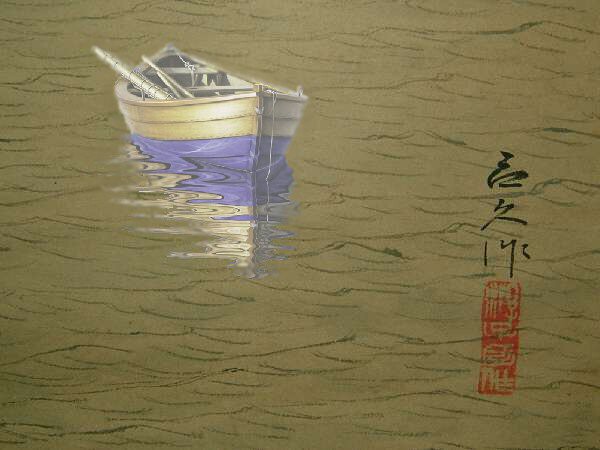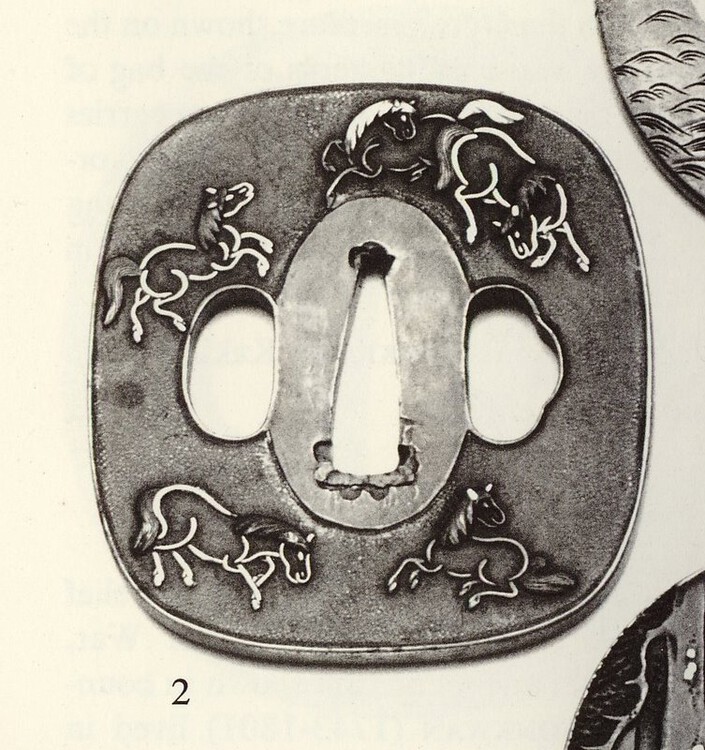-
Posts
3,091 -
Joined
-
Days Won
78
Content Type
Profiles
Forums
Events
Store
Downloads
Gallery
Everything posted by Ford Hallam
-
Hello John, this rather garish orange cord and it's odd wooden bobbins have absolutely nothing to do with the tsuka they are wrapped around. I'd suggest taking it off...then the mystery will disappear . It's isn't a lanyard or udenki either (sword retaining cord)...that was typically attached via the tsuba or on tachi via the pommel (kabuto-gane). regards, Ford
-
James Michener was actually an avid collector of woodblock prints. I believe there is an fairly extensive collection of his in Hawaii...somewhere Personally, I think it all comes down to early toilet training... but Hermes may be absolutely right ...for myself though, I sublimate those urges into actual making :D ...think of me as an enabler .
-
I thought the first was "Ishi" and the last "saku"
-
I don't know who painted this but as they obviously didn't finish it ...not sure what you're after but everyone likes boats so I hope this is an improvement .jpg]
-
They're puppies :D , like these on this panel. Fairly common depiction in late Edo and Meiji period art. I'd suggest the tsuba is late Mito work. p.s. just a friendly hint....it can be a bit of a bother sometimes to have to go to another site to see an image that someone wants information on, particularly if people are on slow connections, that can often lead to queries being ignored or bypassed.
-
....this is a bit like a Rorschach test
-
Hi Mark, there is so very little to go on here but for what it's worth I'll offer a few suggestions :| Despite the rim, which, when added to a plain iron tsuba, can indicate an older swordsmith's or armourers work that has been refined, or gentrified a little, I think this rim is contemporary with the tsuba's manufacture. The obliterated mei is a bit worrying, that sort of damage isn't typical, especially as there doesn't really seem to be any obvious reason for it. Perhaps a much later ( like this year ) attempt to suggest that it was signed once. The style of decoration is quite distinctive, albeit very sparse. I think I'd lean towards late Mito work, the last 50 years of the Edo period. Regards, Ford
-
Hi Ted, those are really very beautiful paintings, very strong modern feel too. I think that when we see this sort of brush work it becomes very clear what really good kata-kiri work can look like. thanks, Ford
-
Hello Ted, I knew I'd seen something similar before...just took a little while to remember where. This is from the Peabody Museum catalogue. It's described as Nara, circa 1790. This example has a sentoku ground but the decorative technique is identical ( and fairly unique ). There was another, very similar in the Hartmann collection but the catalogue image is so small it's not much use uploading. It wasn't attributed. The subject is apparently " The eight horses of Bokuo" and refers to an historic expedition against the tribes of Southern China by the 5th Emperor of the 5th Chow Dynasty. I'd suggest that your tsuba may have a little brother somewhere, with the other 5 horses on. That all I've got... Regards, Ford
-
Here you go, Pete. Some more Kanie to consider in reference to Guido's tsuba. Personally, I beginning to think that the study of tsuba must be accompanied by a pretty broad study of contemporary painting developments. This is after all where the metalworks gained their inspiration, they didn't work in isolation in artistic terms at all.
-
I won't claim to be particularly well immersed in the nuances of iron but the lower half of the piercing work, the leaves and flower, exhibits a unique Akasaka design sensibility to my eyes. Makes me think of the period of the 5th Master, ( can't go wrong saying Tadatoki ) Mid to late 1700's Regards, Ford
-

Wow- Lowest Yahoo!Japan trick I've seen yet!?
Ford Hallam replied to Curran's topic in Auctions and Online Sales or Sellers
So the tsuba they are selling is apparently identical in appearance ( the same image ? ) to the one in the copy of Sasano's book they are referencing. But in your copy of the same book the tsuba is a similar design but clearly not the same object ( tsuba ). Seems just a little suspicious....but you have to admire their deviousness if they have photo-shopped the tsuba they are trying to sell, into a well regarded reference book. Come to think of it, it's brilliant! :D -
Glad to have helped, Chaps. It's not pleasant to be the bearer of bad news but I always feel that knowledge is our best defence in this game. The trouble with this sort of copy is that they are taken from mould of genuine articles and so, are at first glance, very convincing. There have been a few, similar cast items discussed on these pages and I suppose it's just a matter of us all building up, an almost sub-conscious, knowledge base and check list of the possible warning signs. regards, Ford
-
Hmmm...I think this is a modern casting. What appear to be ( rather fluid ) folding lines is nothing more than the evidence of molten wax flowing into the mould that was taken from the original tsuba. The real give away is the fact that the inset bit of metal inside the kozuka hitsu is clearly part of the same metal as the rest of the guard, whereas it should be a bit of non-ferrous metal, copper or shakudo typically. I think there appears to be some evidence of the sekigane ( that was on the original ) at the top of the nakago ana too The patina looks a bit too slick too and the lack of clarity of the mei is a consequence of the poor mould imprint. Sorry...just my opinion.
-
I don't think anyone's getting upset, Lorenzo. All just a bit of teasing we're all big boys after all as for an iron version, Guido....well then that would obviously be sans the nanako and would therefore be called Kanie :D ...and those triple 6 marks are only usually visible by moonlight, well at least mine are
-
duh!...obviously :D In the words of Bruce Lee; " do not concentrate on the finger pointing to the moon or you will miss all the heavenly glory"
-
you bring up a very important point, Lorenzo. That is the difference between connoisseurship, and personal taste. Appreciating what you like is the most natural, and easy thing in the world. It takes absolutely no effort :D ....attempting detached and objective connoisseurship and developing discernment in terms of a particular art form is a completely different undertaking and has nothing to do with our own personal likings. The concept of beauty itself is so open to interpretation that using the word in terms of art appreciation is almost as pointless as the word "nice" :lol:
-
:lol: reading this discussion centred on the nakago ana and seppa dai is a bit like overhearing visitors to an art gallery ignore the paintings and concentrate on the frames The tsuba is, in my opinion, quite a special work. It is clearly ko-kinko...but this doesn't tell us all that much. Judging from the motif and general workmanship I think it well reflects the Momoyama period aesthetic and would date to that time. The colour of the metal and the appearance of the gilding confirms this dating for me. The vertical nanako is not in itself all that unusual, certainly in earlier work. I have serious reservations as to it being Mino work. For similar reasons I don't think Ko-Goto fits either. The openness of the design and the very rare ( for this time period ) representation of a painting style scene ( not unlike the pioneer in this form of representation, Kanie ) in Shakudo seems to very much out of place alongside the typical Ko-mino tsuba which are very busy, almost cluttered, with decoration. Could Kanie have taken a day off from iron and played with some shakudo? ...certainly he was more than skilled enough. The sensitive, sensual almost, modelling of the monkeys expresses a wonderful sense of humour. The plum blossoms are very delicately carved also...something reminiscent of Umetada Myoju in the way they are depicted. All in all, a fascinating and exceptional tsuba. A potential tokubetsu paper perhaps? p.s. My understanding of the allegory is a little different from that previously suggested. A monkey attempting to grab the moon reflected in the water is a popular theme in Zenga (Zen ink paintings). The moon on the water, which looks real, symbolizes the illusion of existence, from the Buddhist perspective there are no permanent, fixed entities that we can catch and hold in our grasp. and I found this bit of additional info too;
-
yeah man! he's obviously "a lover...not a fighter"
-
Beautiful blade, Guido. One thing that strikes me is the way the hamon appears to form around the dragon horimono on the omote. Is this a true reflection of the hamon or has the hadori added to the effect? The reason I ask is that it seems to me that the hamon may have been conceived in this way specifically to accommodate the carving. This suggests that the design and layout of the carving was planned from the start. thanks, Ford
-
no doubt about it....the same guy my initial impression is only reinforced.
-
Sorry Milt, one of the images seemed to distort the appearance of the length. Anthony, can you post some larger images, those are too small to make anything out properly. thanks, Ford
-
I think that "patina" is just what happens when polished steel is handled a bit....give it a while on your window ledge and it will rust nicely Polished steel is simply not a finish that would be used by any traditional metalworker ( apart from sword-smiths :D ) in Japan. It isn't practical and it looks too flashy. The design may well have been based on a painting ( a very bad one ) but the chisel work is very atypical of kata-kiri work. It also seems too long compared too it's width. Taking all these oddities ( the mei placement also ) together leads me to only one conclusion. ...sorry, just my opinion p.s. which end is open to admit the blade's tang?
-
....how often have you seen a kozuka with the mei on the front face like this? I imagine there might be the rare exception to the rule but I can't think of one
-
Hi Milt, the little circles are actually stamped with a cup shaped punch, a bit like nanako is done but obviously to as deep. To be frank, I think this kozuka looks very suspicious...I don't think this is an antique and probably not made in Japan. Just my gut feeling though regards, Ford






